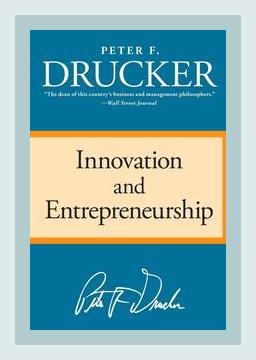Innovation and CreativityR&D ManagementOpen Innovation
Introduction
Peter F. Drucker’s seminal work, Innovation and Entrepreneurship: Practice and Principles, fundamentally shifts how organizations can drive growth and achieve sustainability through consistent innovation and entrepreneurial practices. Emphasizing that innovation and entrepreneurship are systematic and can be practiced by any organization, the book is divided into three main sections: The Practice of Innovation, The Practice of Entrepreneurship, and Entrepreneurial Strategies.
1. The Practice of Innovation
Drucker identifies seven sources of innovative opportunities divided into three categories: internal, industry/market changes, and external factors.
- The Unexpected (Unexpected Success, Failure, or Event):
- Example: IBM’s unexpected success with its computer leasing option highlighted a new market need and led to product innovation.
-
Action: Conduct periodic reviews of past unexpected successes or failures to identify hidden opportunities or threats.
-
Incongruities:
- Example: The American healthcare system’s incongruity between rising costs and patient dissatisfaction spurred the growth of outpatient clinics.
-
Action: Map out current incongruities in your industry and brainstorm innovative solutions to align services with customer expectations.
-
Process Need:
- Example: McDonald’s streamlined food preparation with an assembly-line approach, dramatically improving efficiency.
-
Action: Audit existing processes in your organization to identify bottlenecks and inefficiencies; consider technology or process redesigns to address them.
-
Industry and Market Structure Changes:
- Example: The rise of personal computing disrupted traditional IT models, giving rise to software giants like Microsoft.
-
Action: Stay informed about technological advancements and regulatory changes that may alter industry structures; prepare to adapt quickly.
-
Demographics:
- Example: The aging population in many countries has led to increased demand for healthcare services, spurring innovations in medical technology and eldercare.
-
Action: Analyze demographic trends to forecast future market needs and innovate to meet those needs effectively.
-
Changes in Perception, Mood, and Meaning:
- Example: Environmental awareness has driven demand for green products, spurring innovations in sustainable energy and materials.
-
Action: Monitor social trends and public sentiment; adjust your product offerings or marketing strategies to align with changing values.
-
New Knowledge:
- Example: Advances in biotechnology, especially CRISPR, have revolutionized genetic engineering and opened new avenues for medical treatments.
- Action: Invest in R&D and build partnerships with academic institutions to stay at the forefront of technological advancements.
2. The Practice of Entrepreneurship
Drucker stresses that entrepreneurship is not just about starting new businesses but about instilling entrepreneurial thinking in existing organizations.
- Entrepreneurial Management:
- Example: 3M encourages employees to spend 15% of their time on personal projects, fostering a culture of innovation.
-
Action: Implement policies that allow employees dedicated time for exploring new ideas, fostering a culture of innovation.
-
Entrepreneurship in Service Institutions:
- Example: Mayo Clinic’s collaborative model among physicians, researchers, and educators ensures continuous medical innovation.
-
Action: Establish cross-functional teams to encourage knowledge sharing and collaborative problem-solving.
-
The New Venture:
- Example: Federal Express was founded on innovative logistics and tracking systems, creating a new standard in the delivery service industry.
-
Action: Ensure rigorous market research and test models before fully committing resources to a new venture.
-
Entrepreneurship in the Public Service Institution:
- Example: Public charter schools innovate in educational methodologies, adapting to diverse student needs more quickly than traditional schools.
-
Action: Encourage flexible and interdisciplinary approaches to problem-solving within public or non-profit institutions.
-
The Entrepreneurial Personality:
- Example: Successful entrepreneurs like Steve Jobs exhibit vision, passion, and resilience, driving innovation even in the face of setbacks.
- Action: Cultivate resilience and a willingness to learn from failures; mentorship and continuous self-improvement can help develop these traits.
3. Entrepreneurial Strategies
Drucker outlines key strategies to manage innovation and entrepreneurship effectively.
- Fustest with the Mostest:
- Example: Apple often leads the market with innovative products, like the iPhone, creating an initial competitive advantage.
-
Action: Invest substantially in research and product development to be the first to market with groundbreaking solutions.
-
Hitting Them Where They Ain’t:
- Example: Dell disrupted the PC market by selling directly to consumers, bypassing traditional retail channels.
-
Action: Identify and exploit market gaps where competition is low or non-existent.
-
Ecological Niches:
- Example: The Gore-Tex brand successfully dominates its niche in waterproof fabrics through continuous innovation and quality.
-
Action: Focus on a specific market segment, offering highly specialized products that meet unique customer needs.
-
Changing Values and Characteristics of the Market:
- Example: Nike’s embrace of athleisure aligned with changing consumer values towards fitness and comfort, creating new markets.
- Action: Stay attuned to shifts in consumer values and lifestyles, and adjust marketing or product development accordingly.
Conclusion
In Innovation and Entrepreneurship: Practice and Principles, Drucker presents innovation and entrepreneurship as disciplines that can be systematically pursued within any organization. Through concrete examples and actionable insights, he provides a blueprint for fostering a culture of innovation, encouraging entrepreneurial thinking, and adopting strategies to remain competitive in a constantly evolving marketplace. By applying Drucker’s principles, organizations can harness innovation to create value and achieve sustained growth.
By internalizing and implementing these practice-oriented insights, organizations and individuals can effectively navigate and thrive in the dynamic landscape of innovation and entrepreneurship.
